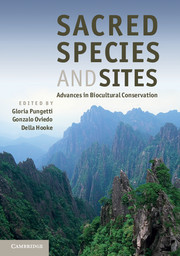Book contents
- Frontmatter
- Contents
- List of Contributors
- Foreword
- Preface
- Acknowledgements
- Introduction
- Part I Concepts and Knowledge
- 1 Sacred species and sites: dichotomies, concepts and new directions in biocultural diversity conservation
- 2 Spiritual values and conservation
- 3 Protected areas and sacred nature: a convergence of beliefs
- 4 Ancient knowledge, the sacred and biocultural diversity
- Part II Sacred Landscapes
- Part III Sacred Sites and People
- Part IV Sacred Species
- Part V Sacred Animals
- Part VI Sacred Groves and Plants
- Part VII Implementation and Conclusions
- Index
- Plate Section
- References
3 - Protected areas and sacred nature: a convergence of beliefs
from Part I - Concepts and Knowledge
Published online by Cambridge University Press: 05 August 2012
- Frontmatter
- Contents
- List of Contributors
- Foreword
- Preface
- Acknowledgements
- Introduction
- Part I Concepts and Knowledge
- 1 Sacred species and sites: dichotomies, concepts and new directions in biocultural diversity conservation
- 2 Spiritual values and conservation
- 3 Protected areas and sacred nature: a convergence of beliefs
- 4 Ancient knowledge, the sacred and biocultural diversity
- Part II Sacred Landscapes
- Part III Sacred Sites and People
- Part IV Sacred Species
- Part V Sacred Animals
- Part VI Sacred Groves and Plants
- Part VII Implementation and Conclusions
- Index
- Plate Section
- References
Summary
Introduction: protection for biodiversity, protection for the spirit
There is now almost universal recognition that for many practical, cultural and ethical reasons parts of the world's land and water surface should be set aside from the mainstream of human activity and maintained in a natural or near-natural state. Although there are many factors influencing decisions to select and protect particular places, two currently predominate: the desire to preserve the full range of naturally occurring biodiversity and the wish to safeguard places regarded as sacred. While these motives may seem a long way apart, there is in reality a considerable overlap, which manifests practically in terms of management strategies in particular places and philosophically in the worldviews and opinions of the people involved. This chapter summarises research (Dudley et al., 2005) that looks at links between protected areas and sacred lands and waters.
Sacred sites and protected areas
The contemporary growth in protected areas – such as national parks and wilderness areas – represents what is almost certainly the largest and fastest conscious deliberate change of land use in history. At the dawn of the twentieth century, a handful of national parks had been established, in the US, Australia, Africa and India. By the time of the Fifth World Parks Congress in 2003, over 10% of the world's land surface was under some form of protection, along with a relatively small but rapidly growing area of coastline and ocean (Chape et al., 2003). The speed with which the world's protected area network has grown demonstrates an extraordinary response to recognition that the world is losing biological diversity, but it has not come without cost. In many countries, people, often including the poorest and politically weakest communities, have been dispossessed of their traditional land to make way for protected areas. This, along with a persistent negligence in including socio-cultural–spiritual concerns into conservation strategies, has created social tensions associated with conservation (Colchester, 2003). Additionally, not all the areas that are designated as ‘protected’ are in reality managed as such and many, perhaps most, protected areas face threats that in the long term mean that they continue to lose some of their values (Carey et al., 2000). Modern protected area strategies need to address these issues more effectively, and links with faiths and with some of their traditional conservation methods is one way of achieving this aim.
- Type
- Chapter
- Information
- Sacred Species and SitesAdvances in Biocultural Conservation, pp. 36 - 45Publisher: Cambridge University PressPrint publication year: 2012
References
- 1
- Cited by

